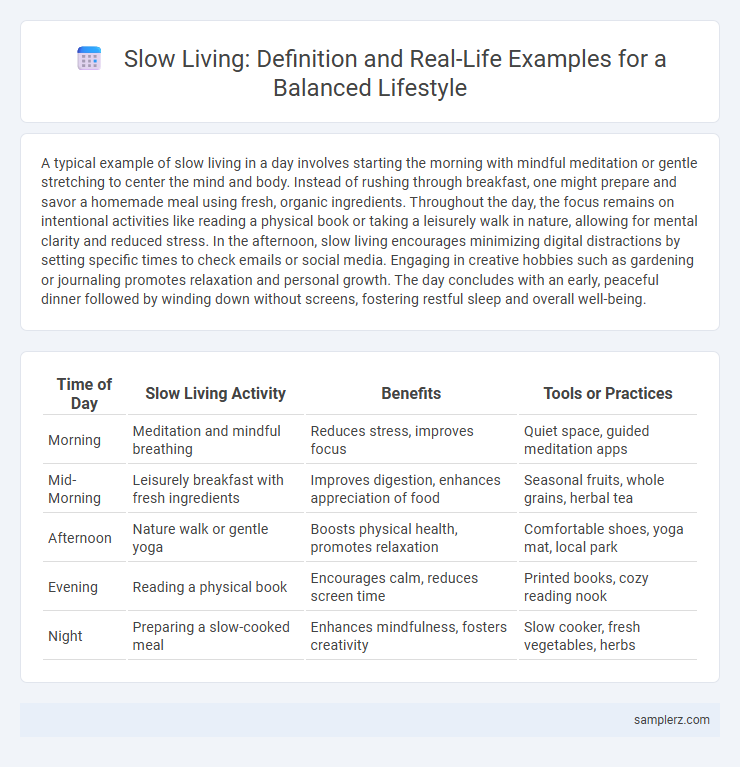A typical example of slow living in a day involves starting the morning with mindful meditation or gentle stretching to center the mind and body. Instead of rushing through breakfast, one might prepare and savor a homemade meal using fresh, organic ingredients. Throughout the day, the focus remains on intentional activities like reading a physical book or taking a leisurely walk in nature, allowing for mental clarity and reduced stress. In the afternoon, slow living encourages minimizing digital distractions by setting specific times to check emails or social media. Engaging in creative hobbies such as gardening or journaling promotes relaxation and personal growth. The day concludes with an early, peaceful dinner followed by winding down without screens, fostering restful sleep and overall well-being.
Table of Comparison
| Time of Day | Slow Living Activity | Benefits | Tools or Practices |
|---|---|---|---|
| Morning | Meditation and mindful breathing | Reduces stress, improves focus | Quiet space, guided meditation apps |
| Mid-Morning | Leisurely breakfast with fresh ingredients | Improves digestion, enhances appreciation of food | Seasonal fruits, whole grains, herbal tea |
| Afternoon | Nature walk or gentle yoga | Boosts physical health, promotes relaxation | Comfortable shoes, yoga mat, local park |
| Evening | Reading a physical book | Encourages calm, reduces screen time | Printed books, cozy reading nook |
| Night | Preparing a slow-cooked meal | Enhances mindfulness, fosters creativity | Slow cooker, fresh vegetables, herbs |
Morning Mindfulness Routines
Morning mindfulness routines enhance slow living by encouraging intentional awareness of the present moment. Practices such as mindful breathing, gentle stretching, and savoring a quiet cup of tea foster calmness and reduce stress. Incorporating these habits into daily mornings cultivates a balanced, peaceful lifestyle centered on intentionality and well-being.
Embracing Unhurried Breakfasts
Embracing unhurried breakfasts involves savoring each bite mindfully, choosing wholesome foods like fresh fruits, whole grains, and herbal teas to nourish the body gently. Setting aside technology and distractions during morning meals promotes relaxation and mental clarity, aligning with slow living principles. This deliberate start cultivates a peaceful mindset that sustains balanced energy throughout the day.
Mindful Commuting Practices
Mindful commuting transforms the daily journey into a moment of presence by reducing stress and increasing awareness through deep breathing and conscious observation of surroundings. Choosing walking or cycling over driving fosters physical activity and a stronger connection with nature, promoting mental clarity and relaxation. Incorporating technology detox by silencing notifications during travel enhances focus and creates a peaceful start and end to the day.
Deliberate Digital Detox Moments
Incorporating deliberate digital detox moments during your day enhances mindfulness and reduces screen fatigue, promoting mental clarity and balanced well-being. Setting specific times to unplug from devices, such as during meals or before bedtime, fosters deeper connections with your surroundings and improves sleep quality. Embracing these intentional breaks supports a slow living lifestyle by prioritizing presence and reducing digital distractions.
Savoring Simple Pleasures at Work
Taking mindful breaks throughout the workday to enjoy a cup of herbal tea or a quiet moment outside enhances mental clarity and reduces stress. Embracing slow living at work means prioritizing deep focus on one task at a time, avoiding multitasking and digital distractions. Creating a calm workspace with natural light and minimal clutter supports relaxation and sustained concentration.
Slow and Intentional Lunch Breaks
Taking a slow and intentional lunch break allows individuals to fully engage with their meal, promoting mindfulness and reducing stress. Choosing whole, nourishing foods and savoring each bite supports better digestion and mental clarity. This rhythm encourages a productive afternoon by prioritizing well-being over rushed multitasking.
Connecting with Nature Daily
Spending 30 minutes each morning walking barefoot on grass enhances mindfulness and reduces stress by deepening your connection with nature. Incorporating outdoor meditation or journaling sessions amid trees boosts mental clarity and emotional well-being. Regular intentional interactions with natural surroundings foster a slower, more balanced lifestyle grounded in present-moment awareness.
Creating Evening Unplugged Rituals
Creating evening unplugged rituals enhances mindfulness by reducing screen time and fostering relaxation before bed. Activities like journaling, meditation, or reading physical books promote mental clarity and improve sleep quality. These slow living practices balance daily stress, encouraging a calm and intentional lifestyle.
Practicing Gratitude Before Bed
Practicing gratitude before bed enhances slow living by fostering mindfulness and reducing stress, which promotes restful sleep. Reflecting on positive moments or writing a gratitude journal shifts focus away from daily anxieties, creating a calm, deliberate end to the day. This simple habit cultivates a deeper appreciation for life's small joys, aligning with the core principles of slow living.
Reflecting on the Day’s Simple Joys
Taking time in the evening to pause and reflect on the day's simple joys enhances mindfulness and promotes emotional well-being. Noticing moments like a warm cup of tea, a gentle breeze, or a heartfelt conversation cultivates gratitude and slows the pace of life. This practice aligns with slow living principles, encouraging intentional awareness and deeper connection to daily experiences.

example of slow living in day Infographic
 samplerz.com
samplerz.com